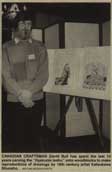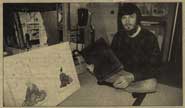David Bull: Woodblock Print Artist
"Japan is such a fascinating country! Individual energy is balanced, so that individuals and society operate in step with each other. I'm not going home to Canada. I'm grateful if I can carve woodbIocks, and I'm delighted to see my skills improve - nothing gives me greater pleasure!" The enthusiasm shown by David Bull (47), an English-born Canadian, is enough to make any Japanese happy.
As a child, Bull moved from place to place with his saxophonist father. He studied music at the University of British Columbia, but quit after a year. He also studied flute in London, but soon returned to Vancouver on the west coast of Canada, where he found employment in a music store.
One day he saw some ukiyo-e prints in a small gallery in Toronto, and was immediately hooked. Later, on the transcontinental railroad that spans the North American continent, be met a Japanese woman, whom he later married.
His wife agreed to return with him back to her homeland, where he wanted to study woodblock carving. They brought their two daughters with them, little Fumi strapped to mommy's back, and Himi led by the hand.
To support his family, Bull opened an English conversation school and, using his multifarious talents, made and sold handcrafted wooden toys while teaching himself the art of woodblock printing.
"I was watching the children play with traditional Japanese playing cards, which I had never seen before," he recalls. "Some of them reproduced prints by Ogata Korin, Kitagawa Utamaro, and Katsushika Hokusai. The ones that really caught my eye, though, were by Katsukawa Shunsho, who was active in the mid-Edo period."
"Each of the men that Shunsho depicts has his own individual character. Their faces are similar, but their clothes and gestures are different; it was the character of his men, and the poses of his women, that attracted me to his prints."
Bull has been studying Edo-period woodblock printing for the past 18 years. In the Edo period carving and printing were two separate occupations, but Bull does both, using only technologies that were available when the originals were made over 200 years ago.
"There was a division of labor between carvers and printers, but that era is over." he says decisively. "It's just a natural result of the changing times. If you don't maintain communication with your audience, the quality of your work won't improve. It's no wonder that the old-style artisans have no successors."
Last January, Bull finished carving and printing his reproduction of the last print in Shunsho's masterful series, One Hundred Portraits.
That 10-year project now completed, he's set his sights on new horizons.
With the rapid development of computer technology, Bull is reaching out overseas via the Internet and has created a group called 'Baren' (named after the round pad used to press the paper against the inked woodblock) where members exchange opinions and information about different techniques and materials and with the participation of professional artists overseas, operates on the cutting edge of the woodblock print world.
"lt's just a personal thing," he says, "but I'd like to try my hand at carving four or five lines within the space of one millimetre."
TV Listings
The 'Woodblock Shimbun' has a full selection of TV programs on file. Videos available include some of David's news appearances, complete feature programs, and some short documentaries on his work. The files are in QuickTime format, and can be easily viewed with your browser.
Program listings are on the Index page ... ![]()
Woodblock Man Carves Niche
Woodblock carver David Bull refuses to be called an 'artist' or 'sensei'. "I'm just the guy who carves a piece of wood," Bull said. "All I do is copy what the real artists did." Since 1989, the Canadian university dropout who once played the flute on the streets of London has spent many hours bent over his woodblocks, nose and beard almost touching the surface, as he carved toward a self-appointed goal: the recreation of 18th century ukiyo-e artist Katsukawa Shunsho's 'Hyakunin Isshu: Poems from One Hundred Poets' series. (1999)
Full Story. ![]()
A Traditional Woodblock Printer
Surrounded by carving tools, brushes and bowls of
pigment, he spends hours absorbed in the exacting work that has
become both a passion and a ten-year project. A Canadian who moved to Tokyo in 1986, David Bull
has made an extensive effort to learn and practice woodblock
printmaking as it was mastered in Edo-era Japan. He is currently
producing a series of woodblock prints using designs by the famous
Ukiyo-e artist Katsukawa Shunsho. The theme is the 100 poets of old
Japan (Hyakunin Isshu) and in four years he has completed 40 of them.
He expects to finish the collection in 1998. (1992)
Full Story. ![]()
Japanese Art with a Canadian Touch
A British-born artist from Canada is holding an exhibition of his 60 works of ukiyoe woodblock prints, part of his 10-year project to carve and print the Hyakunin Isshu poem collection. (1998)
Full Story. ![]()




